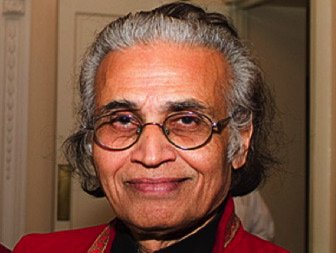
|
 |

|
 |
Dr. Sunil Kothari - Ananda Shankar Jayant, Hyderabad e-mail: anandasj@rediffmail.com December 15, 2009  Dr. Sunil Kothari, dance historian, scholar, author, is a renowned dance critic, having written for The Times of India group of publications for more than 40 years. He is a regular contributor to Dance Magazine, New York. Dr. Kothari is a globetrotter, attending several national, international dance conferences and dance festivals. He has to his credit more than 14 definitive works on Indian classical dance forms. Kothari was a Fulbright Professor and has taught at the Dance Department, New York University; has lectured at several Universities in USA, UK, France, Australia, Indonesia and Japan. He has been Vice President of World Dance Alliance Asia Pacific (2000-2008) and is Vice President of World Dance Alliance Asia Pacific India chapter, based in New Delhi. A regular contributor to www.narthaki.com, Dr Kothari is honored by the President of India with the civil honor of Padma Shri and Sangeet Natak Akademi award. What is the place of such conferences in the performing arts? How necessary is academic discipline, for furthering one's art? I have been associated with Natya Kala Conference from its inception. In the early eighties as was the trend, the need for a deeper study of the Natyashastra texts was considered necessary. In order to understand various aspects of performances, it indeed is important to study them especially from the point of view of aesthetic theories. To appreciate the staggering variety and multiplicity of dance forms, such a conference has played an important historical role. We in India have an over emphasis on the performances. Therefore, scholarship in the performing arts has developed on the lines of finding out how the Natyashastra texts validate researches in different dance forms, which as a process of Sanskritization, laid emphasis on classical categories. If one has an academic discipline, it helps one to perform classical aspects more accurately. And not only repeat what a traditional guru has taught. Even if one does not have an academic discipline and one learns by rote, but is gifted, one can cast a spell by his /her art with abhinaya and technical skills in a startling way. Watching over the years in Kathak Shambhu Maharaj, Lachhu Maharaj, Birju Maharaj, in Odissi Guru Kelucharan Mahapatra, to give a few examples, one has realized even when they did not have a deep scholarly knowledge of the Natayashastra texts, on account of their exceptional gifts they illumined the art. But to appreciate and relish their performances, if one has an academic discipline, one enjoys the performances more than one who does not have an academic discipline. Today in changing times, an academic discipline helps a dancer to come to terms with issues arising out of globalization and how to tackle the problems facing them for their career. It also helps a dancer to project an image as an artist with social awareness, for the academic discipline leads a dancer to study several aspects connected with dance and life. A dancer does not live a secluded life and starts questioning to relate dance to life. Are classical Indian dance forms slowly becoming just the face of tourism? It is a loaded question. The globalization, the marketing, the packaging, the economic issues and other factors involved for promotion of the performing arts have invariably spurred tourism industry to explore and exploit them. Classical Indian dances offer several challenges to several categories of audiences which often do not have any entry point into what is happening on the stage. The glamour, the glitter and the glitz, the exotic element have all contributed to this state of the classical arts today. Your title 'Where do we go from here?' Do you think there are clear paths of where the dance will go or is it very fuzzy and being pulled in many directions? Having seen classical dances for more than half a century, one questions where do we go from here. We are performing the past and have not cut it off from its umbilical cord. What one sees is a certain mindlessness and a lack of awareness about the arts, the role arts can play, or say specifically dance can, is lost sight of. The assembly line production of dancers and the problems of the transition of performers from the hereditary class to the middle class, the rampant commercialization of the context too has affected the dance sequence. In its solo avatar, the form certainly has thrown up exceptionally gifted dancers. But now the danger signals are evident. The mindlessness and mediocrity accompanying quantification and promotion in the name of supporting art without the necessary checks and balances, have caused havoc. It has for example led to the factory syndrome of a conveyor belt production of dancers, followed by pre-fabricated arangetrams, mechanical presentations and loss of feeling. In the urban centres, performances do not attract crowds and audiences are dwindling except for special events. Yet, one encounters a false hype and euphoria during say, December Festival season in Chennai. Regarding second part of your question, dance is bound to develop in many directions. I feel confident dancers shall meet the challenges posed to them. Tell us about your new book. Sattriya Dances of Assam. We have completed photo documentation recently and Marg Publications shall release the book by September 2010. Let us know the secret of your passion for dance and your extraordinary energy. You are very kind to compliment me. I have enjoyed working in the field of dance. I do not know about extraordinary energy. I hope I shall be able to carry on. Contact: sunilkothari1933@gmail.com |